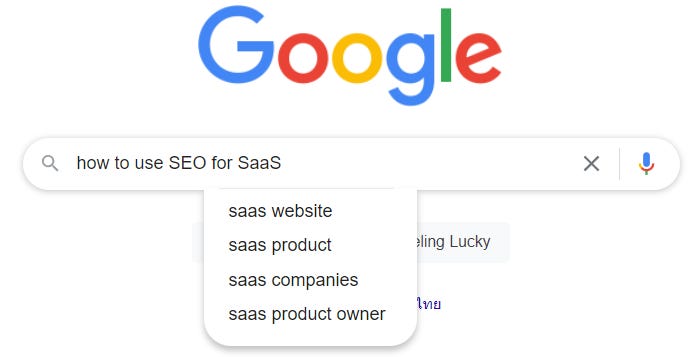AbdulGaniy Shehu is the founder and chief content strategist and Your Content Mart, an agency focused on SEO-driven SaaS content marketing..
We had a fantastic chat about how to do this, including the 5 main content types, how to get the ideas, produce and measure the content.
Key links:
Your Content Mart’s ROI-driven process
What type of content attracts SaaS user signups?
The short answer is middle-funnel (MOFU) and bottom-funnel (BOFU) content, which is the focus of my agency.
Before launching Your Content Mart, I interviewed a lot of founders and asked questions about how they drove revenue from their content.
A mistake a lot of people were doing was making generic, top-of-funnel content on really broad topics like email marketing tips, what is email marketing, etc.
While they are good topics they have two major issues.
First, they are super competitive topics to rank for. It will take a very long time, perhaps even years to rank these because of the competition from other websites like HubSpot, MailChimp for example, or Wikipedia.
Second, they have low buyer intent. Users searching for these topics are just in learning mode. These broad topics aren’t the same as middle and bottom-funnel topics, which target people who are already solution aware and have something in mind that they’re looking for.
I found out that one of the best ways was using MOFU and BOFU content.
What is a good example of MOFU and BOFU content?
There are about five different types of good middle and bottom-funnel content pieces:
Comparison posts. This is a piece comparing one product versus another. You could compare your product against a major competitor, such as Sendfox versus MailChimp.
Alternatives posts. These are typically for when people have an idea of what product they want to use, but they are looking for alternative of the same thing. For this type of post it is good to make a listicle.
💡Tip: List your product as the first alternative. If you list your product at the end, users may not scroll that far or read that much of the article to discover it.
Product use cases and features. These posts identify the use case of products and create a landing page or a post targeting this. For example, if your product was a Twitter scheduling application, you may write a post or page about tweet makers, Twitter analytics tools, etc.
Templates. This is where you have a software which helps people to do something and you offer a template of that thing. For example, you may have a contract signing software, so you can create template posts around common contract agreements that people might create using your tool.
Best X for Y. This post overlaps with alternatives, but it is not the same thing. So for example, if you have a productivity tool for remote workers, you might write about The Best Productivity Tools, planning apps, etc. You are targeting users who are aware of the solution generally but don’t know which type of application to choose.
🖐️ How many products to cover in a listicle? For the number of products to cover in a listicle article, you should check the SERPs. We don’t usually go beyond 7, but if the competitors are listing more then maybe you want to make a long list and break it up into subcategories.
What’s your advice on choosing an angle for these pieces?
I don’t think adding the number of applications covered in your post into the title makes that big of a difference. But users do want to see something that your content is most recent. So make sure if you put the year in your title, you keep updating that year as time goes on.
When researching your topics, try to Google the keyword and see what others have written about it. Then you can see if you can do a better angle and improve your chances of ranking.
One way to do this is if your competitors have covered the topic very broadly, then maybe your version can categorize it based on a particular use case.
For example, if you see there are many SEMRush alternative posts, you can come up with an angle that is fit for a particular target user like small businesses.
How to discover MOFU and BOFU keyword opportunities?
A big mistake people make is using keyword research tools like ahrefs, seeing a low or zero search volume and moving on. Most keyword research tools are not perfect.
Many middle and bottom-funnel keywords show no volume or under 50 searches a month.
This is why we start with audience research first.
We ask the audience questions like, why are they using a particular product, what are the best use cases are, and what is the most useful feature?
Ask is what competitors users were exploring before, or are already using.
Another thing to ask is what pain points they have that the software helps them to solve.
Then, you can move on to validation of those keywords.
You can use something like Google autosuggest in an incognito browser. Type in the query and see if Google auto-suggests the answer.
If it is not auto-suggested, then maybe there is not many people searching this topic.
What are some common mistakes?
One common mistake that I see people make is mismatching the intent of this search topic with the article.
You need to put yourself in the shoes of someone who is searching for that keyword. Ask yourself, what are they actually looking for? Make sure you give them that.
For example, don’t try to create a post when someone is looking directly for a tool to sign up for.
Another example is don’t do a listicle with many options when people are trying to do a comparison between two tools.
Thirdly, make sure you focus your comparisons on one versus another.
Another issue is that I see people doing topics that are unrelated to what their product does.
For example, a web hosting provider writes about the best e-mail marketing tools. This doesn’t serve any purpose other than trying to generate traffic for the web host. But it won’t lead to signups of their service.
This comes back to the same problem that I mentioned earlier. They are doing it as a method to get traffic.
How to measure performance?
There are a few things to do here.
First, check the ranking after a few weeks or months. If it is not ranking, then something might be wrong. Typically the keywords targeted are not that competitive so you should rank fairly quickly .
Then, check the conversion rate of signups or leads. We see a conversion rate of 5% to 15%. Some people will see lower conversion rates depending on how competitive their niche is.
Third, check the conversion rate of the MOFU and BOFU content versus the top-of-funnel content.
If the conversion rate is lower, it could mean that the user experience is poor or there is too much friction to sign up for a trial.
How to promote?
For all content, the promotion depends on the type of content that you have.
BOFU content is not always suitable for promotion on social media, it is often seen as too salesy to promote like a regular post.
But for a listicle, such as the best tools for a particular use case, they could be promoted on social. You could repurpose it as a carousel for LinkedIn as well.
You should also explore PPC. You can run Google ads, Facebook ads, and Twitter ads to your content. The biggest area to focus on is retargeting.
How do you make a plan for MOFU and BOFU content?
Here at Your Content Mart we use our own ROI-driven content framework with five phases.
1st, audience research. We ask who is the target audience, what are the best customers, and why did they sign up? We want to identify the pain points and jobs to be done.
2nd, formulate your content strategy. This is where you set up the foundation. Here you validate the ideas and information you gathered in the research stage and turn them into keywords. You will also want to work out which keywords to target first and how you will promote them
3rd, content production. Not all writers can create bottom-of-the-funnel pieces. You need someone who knows how the product works. You can’t convince a reader without knowing the product inside out and what are the best features.
4th, content promotion. We talked about content promotion before, but this also includes getting links to articles to make sure that they rank higher in the SERPs.
5th, making sure the analytics are set up and tracking conversions. This includes making sure Google Analytics is properly configured to track trial signups.
Some example results here for us have been driving about 1,300 sign-ups within six months using bottom-of-funnel content. Or one article which got 44 organic sessions and 2 sign-ups in the first month, and continued to increase the traffic over time.
🖐️ How much content to make? The amount of articles that you tackle at once depends on the founder, how fast you want to go and how much resources you want to invest. My suggestion is that you aim for at least four pieces per month, one per week, as the bare minimum.
🖐️Why do these topics rank so quickly? The reason why they rank faster, is that your site going to have more authority in that space compared others and is already referenced a lot in that space.
Who is doing it really well?
There are a few interesting examples of companies that are doing this well.
Podia. They’ve nailed the comparison content and are ranking well.
Pipedrive, also leveraged mid-funnel content very well.
Signaturely, have been doing a great job with templates.
Ben: I hope you found this interview as interesting as I did. For taking action, I’ve decided to test out a couple of low search volume topics myself on this blog to see how long it takes to rank and what the results are.
I like AbdulGaniy’s suggestion to tackle one a week, which I think is pretty easy for people to start testing for their own products.











How to use SEO to acquire users | AdulGaniy Shehu